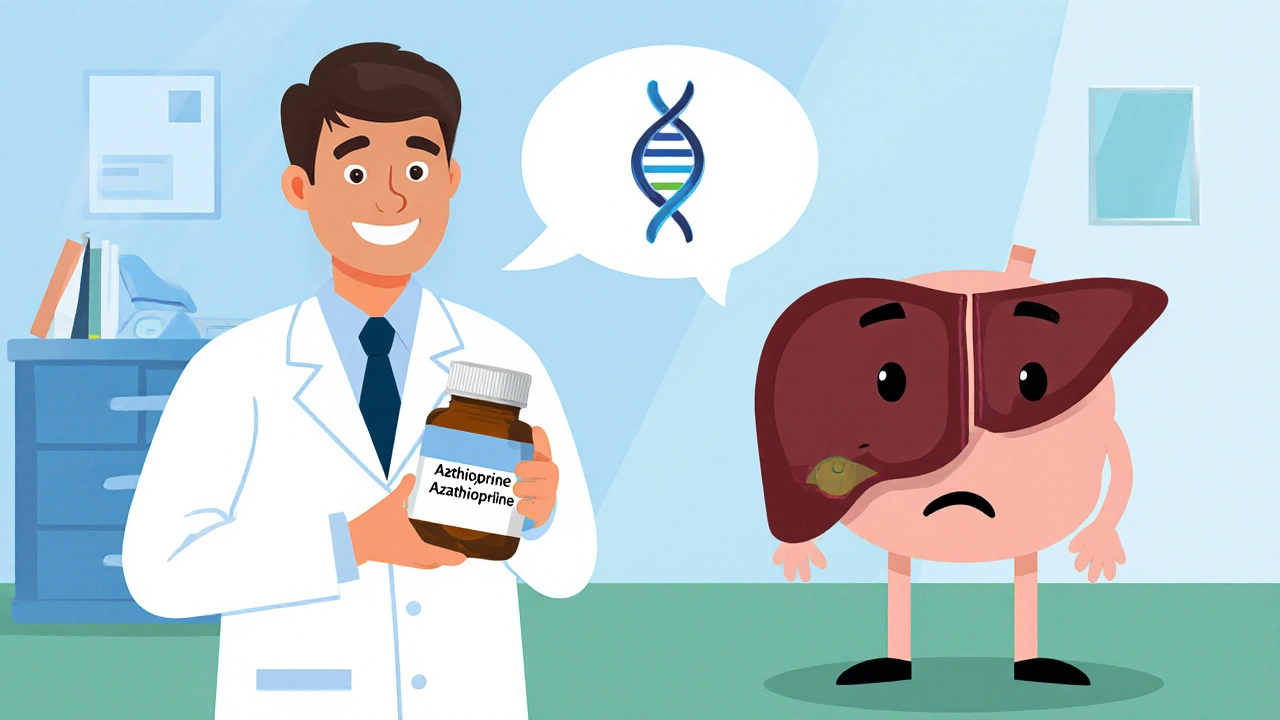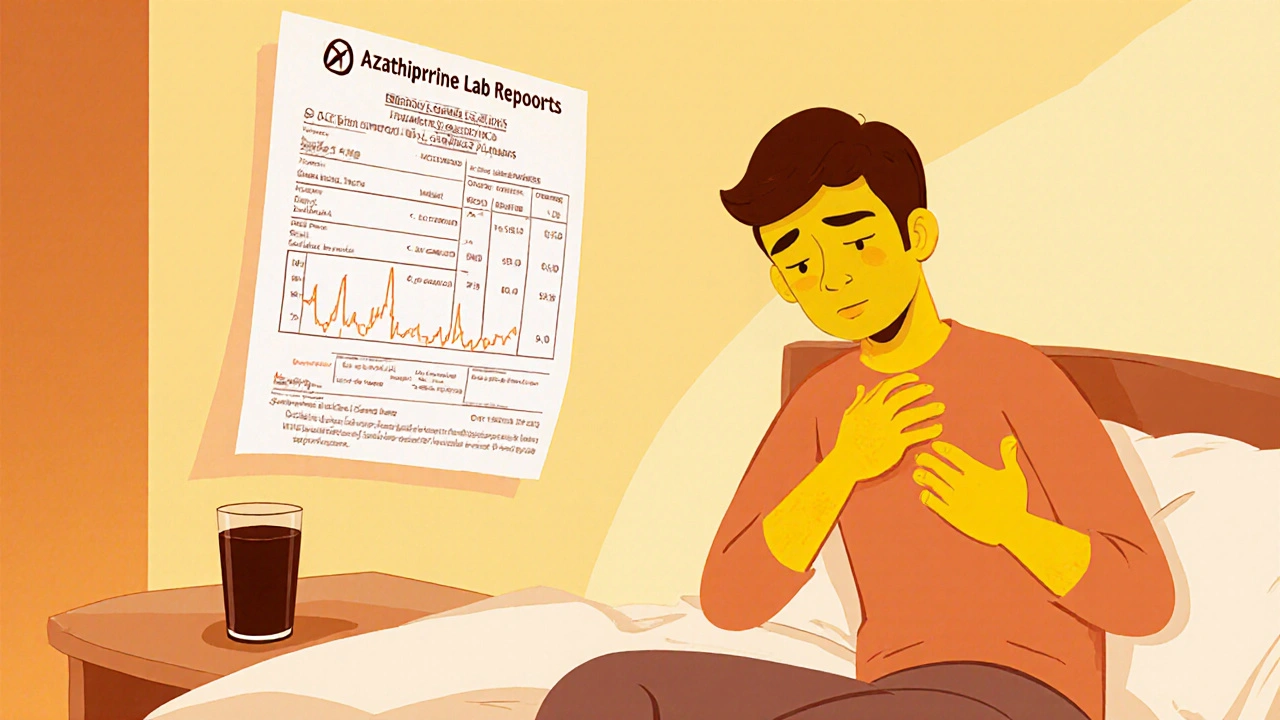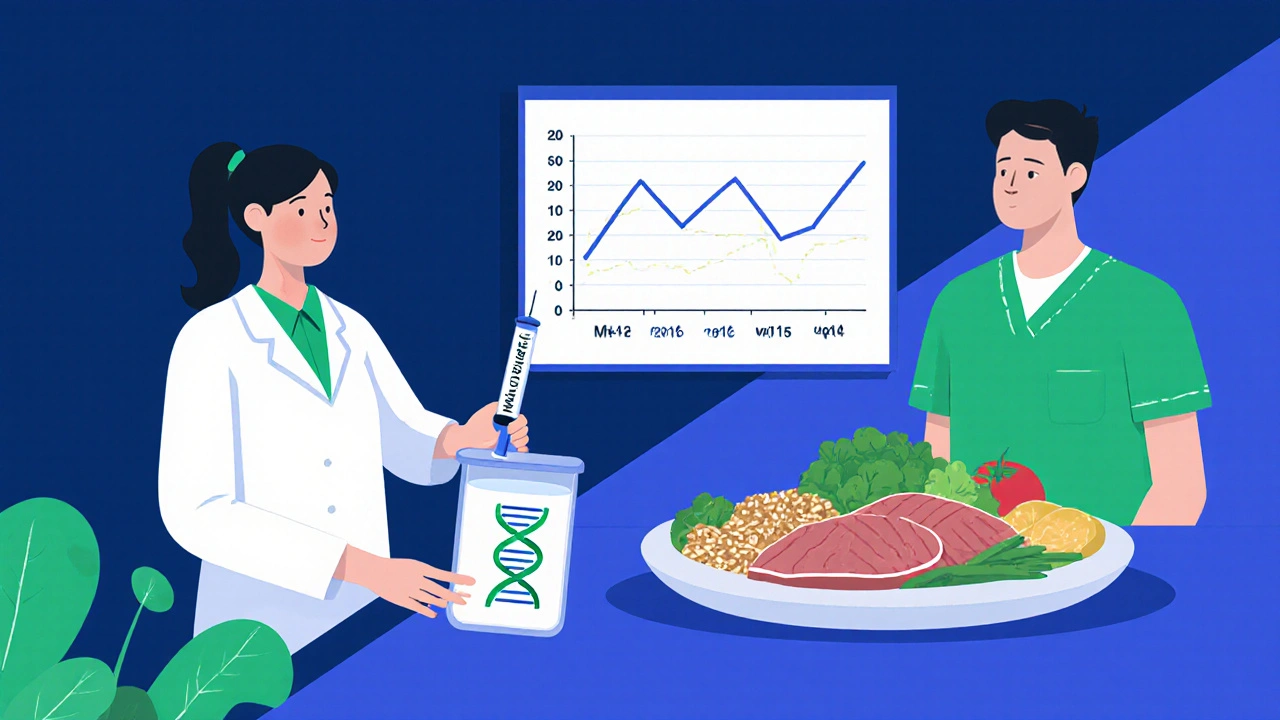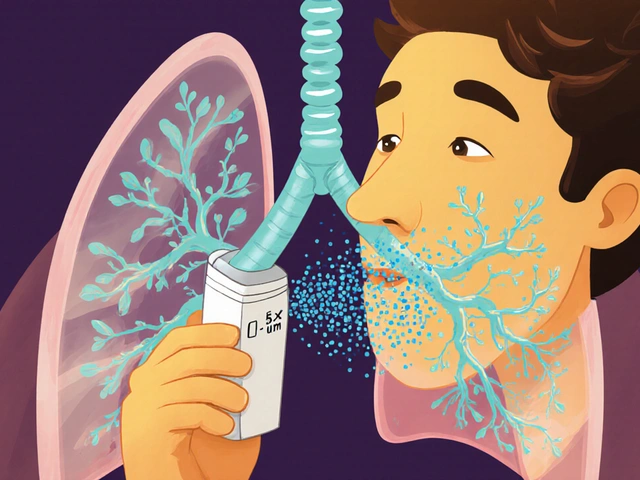
Azathioprine Liver Enzyme Monitor
Liver Enzyme Risk Assessment Tool
This tool helps determine the risk level of azathioprine-induced hepatitis based on your liver enzyme levels. According to medical guidelines, a rise in ALT or AST above 3 times the upper limit of normal (ULN) often signals potential injury.
Ever wondered why a medication that controls your autoimmune disease might turn your liver into a trouble spot? Azathioprine-Induced Hepatitis is a form of drug‑induced liver injury (DILI) that occurs when the immunosuppressant azathioprine damages liver cells. It’s not common, but when it happens it can feel scary because the liver is the body’s detox hub. This guide walks you through what triggers the injury, how to spot it early, and what steps you can take to protect your liver while staying on the medication.
What is azathioprine and why does it matter?
Azathioprine is an oral immunosuppressive drug first approved in the 1960s for organ transplantation. Doctors also prescribe it for inflammatory bowel disease, rheumatoid arthritis, and systemic lupus erythematosus. It works by interfering with DNA synthesis in rapidly dividing cells, especially immune cells, which reduces inflammation.
Because it targets dividing cells, azathioprine can also affect liver cells (hepatocytes). In a minority of patients, the drug’s metabolites accumulate and cause oxidative stress, leading to hepatitis.
How does azathioprine‑induced hepatitis develop?
The liver injury follows a few biochemical steps:
- Metabolism to 6‑mercaptopurine (6‑MP): Azathioprine is rapidly converted to 6‑MP, which is then transformed into active thioguanine nucleotides (TGNs).
- Genetic variation: People with low activity of the enzyme thiopurine methyltransferase (TPMT) or nudix hydrolase 15 (NUDT15) cannot clear TGNs efficiently.
- Cellular damage: Accumulated TGNs generate reactive oxygen species, damaging hepatocyte membranes and triggering inflammation.
These steps explain why routine blood tests are vital before starting azathioprine and why dose adjustments based on TPMT activity are standard practice.
Signs and symptoms you should never ignore
Azathioprine‑induced hepatitis often sneaks in without dramatic symptoms. Still, there are red flags:
- Persistent fatigue or vague malaise
- Upper‑right abdominal discomfort
- Dark urine or pale stools
- Unexplained itching (pruritus)
- Jaundice - yellowing of the skin or eyes
When you’re on azathioprine, it’s a good habit to check liver enzymes every 2-4 weeks for the first three months, then every 3-6 months thereafter. The key numbers are:
- ALT (alanine aminotransferase) - a rise above three times the upper limit of normal (ULN) often signals injury.
- AST (aspartate aminotransferase) - similar thresholds apply.
- Alkaline phosphatase and bilirubin - elevations suggest more severe cholestatic patterns.

Confirming the diagnosis: tests and procedures
Blood work alone can point you in the right direction, but doctors may need extra data:
- Serum autoantibodies: Rule out autoimmune hepatitis, which can coexist with drug injury. \n
- Imaging: Ultrasound or elastography checks for fatty liver or fibrosis that could confound results.
- Liver biopsy: In uncertain cases, a biopsy provides histologic proof of hepatitis and helps differentiate drug‑induced patterns from other causes.
During a biopsy, pathologists look for lobular hepatitis, necrosis, and eosinophilic infiltrates - hallmarks of DILI.
Management strategies: what to do when hepatitis appears
Once azathioprine‑induced hepatitis is confirmed, the primary step is to stop the offending drug. Here’s a practical roadmap:
- Discontinue azathioprine immediately. In many cases, enzyme levels normalize within 2-4 weeks.
- Supportive care: Hydration, dietary adjustments (low‑fat, high‑protein), and avoidance of alcohol.
- Corticosteroid bridge: Short courses of prednisone (40‑60mg daily) can suppress inflammation while an alternative immunosuppressant is introduced.
- Alternative agents: Mycophenolate mofetil, methotrexate, or newer biologics (e.g., ustekinumab) may replace azathioprine, depending on the underlying disease.
- Re‑challenge? Rarely, after full recovery and with a drastically lower dose, clinicians may retry azathioprine under strict monitoring, especially if no other options exist.
Patients with severe liver injury (ALT/AST >10×ULN or bilirubin >2mg/dL) may need hospitalization and consultation with a hepatologist.
Preventing azathioprine‑induced hepatitis before it starts
Prevention hinges on three pillars:
- Genetic testing: TPMT and NUDT15 genotyping helps tailor the initial dose. Patients with low‑activity alleles start at 10‑25% of the standard dose.
- Baseline labs: Check ALT, AST, alkaline phosphatase, bilirubin, and CBC before therapy.
- Monitoring schedule: Follow the enzyme trend closely-every 2weeks for the first month, then monthly for three months, then quarterly.
Adhering to these steps reduces the odds of serious liver injury to under 1% in most cohorts.

Comparison with other common drug‑induced liver injuries
| Feature | Azathioprine‑Induced Hepatitis | Acetaminophen Toxicity | Amoxicillin‑Clavulanate Injury |
|---|---|---|---|
| Typical Onset | 2‑12weeks after starting | Within hours of overdose | 4‑12weeks after therapy |
| Enzyme Pattern | Hepatocellular (ALT ↑↑) | Massive ALT/AST ↑↑↑ | Mixed hepatocellular‑cholestatic |
| Genetic Risk | Low TPMT/NUDT15 activity | Glutathione depletion | HLA‑DRB1*07:01 association |
| Management | Stop drug, consider steroids | N‑acetylcysteine, supportive care | Discontinue, monitor, steroids if severe |
| Prognosis | Usually full recovery | High mortality if untreated | Usually resolves, rare chronicity |
Quick tips to remember
- Test TPMT/NUDT15 before prescribing.
- Baseline liver panel is non‑negotiable.
- Watch ALT/AST - three‑times ULN = red flag.
- If enzymes spike, stop azathioprine and consider a short steroid bridge.
- Document any alternative immunosuppressant chosen.
Frequently Asked Questions
Can azathioprine cause permanent liver damage?
Most patients recover fully after the drug is stopped. Permanent damage is rare and usually linked to delayed detection or co‑existing liver disease.
Do I need lifelong liver monitoring after an episode?
If enzymes normalize and you stay off azathioprine, annual liver panels are sufficient. If you restart the drug, resume the original monitoring schedule.
Is it safe to use over‑the‑counter pain relievers while on azathioprine?
Acetaminophen at ≤2g per day is generally safe. Non‑steroidal anti‑inflammatories (NSAIDs) can add stress to the liver and should be used cautiously.
What symptoms should prompt immediate medical attention?
Sudden jaundice, severe abdominal pain, vomiting, or a rapid rise in ALT/AST (>10×ULN) warrants urgent evaluation.
Are there any dietary recommendations during recovery?
Focus on lean protein, fresh vegetables, and whole grains. Avoid alcohol, fried foods, and excess sugars, which can strain the liver.
Understanding the link between azathioprine and hepatitis empowers you to catch trouble early, act decisively, and keep your liver healthy while managing the underlying disease.





There are 5 Comments
Emily Rankin
Life on immunosuppressants feels like walking a tightrope over a canyon of uncertainty. We balance the miracle of disease control with the whisper of the liver's delicate dance. Azathioprine offers relief, yet it can also cast a shadow over our hepatic sanctuary. The key, dear reader, is vigilance-regular labs become the lanterns lighting our path. Imagine each ALT reading as a gentle pulse, telling us whether the storm is brewing. When the numbers rise, we must pause, breathe, and adjust our sails. Hope thrives when we empower ourselves with knowledge and partner closely with our physicians. Together we can navigate these waters and keep both mind and liver thriving.
Rebecca Mitchell
Wow the liver drama is real and azathioprine just loves to surprise us
Roberta Makaravage
Let’s get real: azathioprine is a powerful drug that can wreak havoc on the liver if you ignore the genetics. People who skip TPMT testing are basically gambling with their health 📉. The moral is clear-responsibility lies with both the clinician and the patient 📚. If you notice dark urine or jaundice, act immediately; delay is a recipe for disaster 🚨. Stay informed, stay safe, and don’t let ignorance become your downfall 😊.
Lauren Sproule
Hey friends, just wanted to say that monitoring your liver while on azathioprine is super important. You cant just ignore those test results they are like a friendly reminder from your body. Make sure you get that baseline panel and keep the follow‑ups regular it really helps. If you feel any weird fatigue or yellow skin let your doc know asap. We all gotta look out for each other and stay healthy together.
CHIRAG AGARWAL
lol i dont care if you read a whole article when a pill messes up your liver
Write a comment
Your email address will not be published. Required fields are marked *